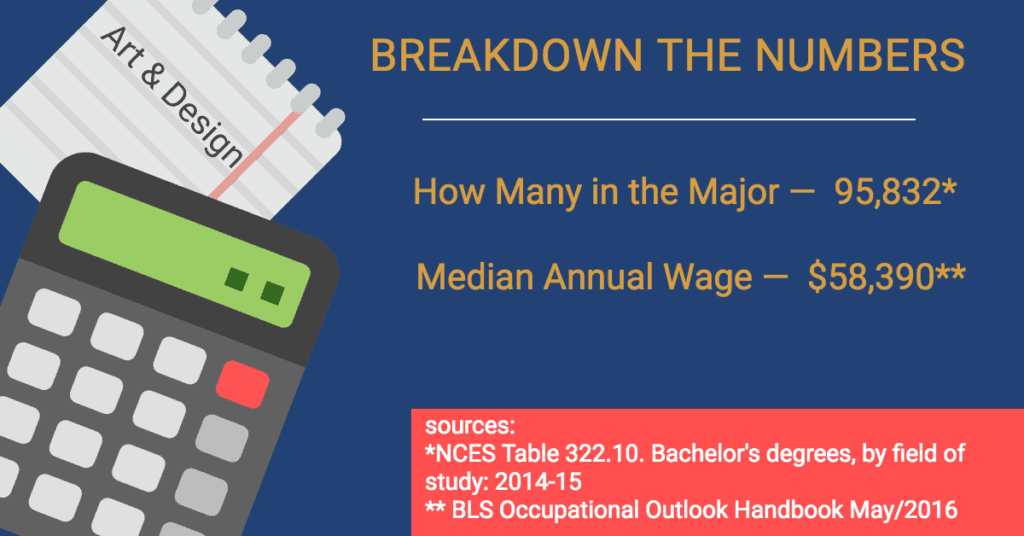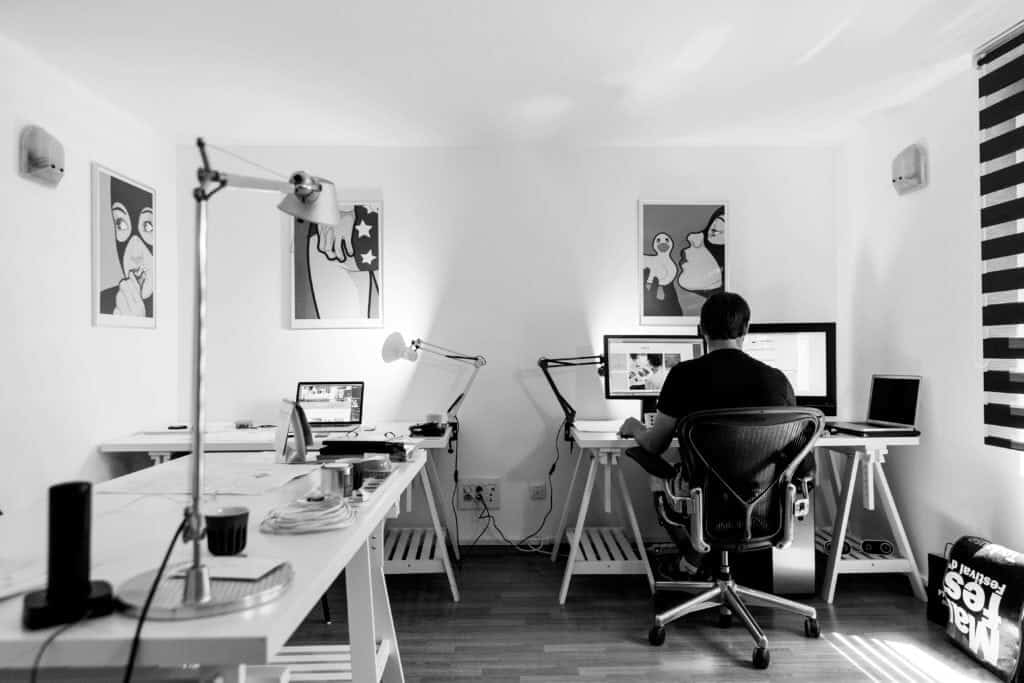
If you love to draw, paint, take photos, make things, and express ideas in a visual way, you may have considered going to school to become an artist.
And chances are, if you’ve spoken those thoughts out loud, someone said, “But you can’t make a living as an artist!” It may have been a friend, a partner, or your mother (it was probably your mother), but you can answer with a confident, “Yes, I can!”
There are a multitude of career options that reward creativity, imagination, and craft, from the traditional studio arts to product design, marketing, and packaging. Colleges and universities all over the nation have developed innovative, cutting-edge art and design programs that prepare aspiring graphic designers. for 21st century professional life in the creative fields.
So your mother can stop worrying. College Consensus has put together a helpful overview of the higher education and job market terrain for everyone who is considering a graphic design degree program. program in Art and Design, including the most in-demand concentrations and the careers on the rise.
What is Graphic Design or Graphic Arts?
Graphic design began as cave drawings from early Ice Age and written writings from Sumera. With printing, communications via photography and typography expanded. Graphic designers have built up their knowledge of the past by integrating modern technology into modern creativity. The modern graphic design has continued its expansion due to digital technologies. Digital design uses computer software applications, animation, and interaction typographic techniques to present and sell product concepts. The U.S. Bureau of Labor Statistics says there are about 281,000 graphic design jobs available at the end of 2019.
What to Expect From a Graphic Design Program?
Core courses can vary with a Bachelors of Art in a Graphics design program. Learning graphic design prepares problem-solving and design thinkingwith hands on experience. Graphic design programs encourage students to explore their artistic process by providing practical experience through research. The most Graphic Design Bachelors Degree programs are 4 years in duration with credit requirements between 80-180 credit hours. Graphic design courses might offer introductory courses in the design field and artistic expression, as well as electives covering particular aspects in graphic design. Tuition rates are dependent upon the institution selected.
How much does a Bachelors Degree in Graphic Design cost?
The Graphic design student can typically spend between $780 to $2504 per course as they study graphic design. Charges include tuition and school expenses per class or elective courses. Campus housing is frequently required for additional charges. Tuition rates differ from one student to another. Tuition fees vary according to institution designations as public or private. Upon request, a student may receive no additional expenses. Generally speaking online courses offer lower tuitions for designers. Financing your bachelors degree is as easy as filing a free application: Applicants need to complete an online FAFSA online form. Internship opportunities may be available.
What Are the In-Demand Major Options?
Of course, students of an artistic bent are always going to be drawn to the traditional studio arts like photography, sculpture, and printmaking, but the most in-demand majors – both for students and for employers – are the design-related programs that combine science and the arts, such as:
- Human-Computer-Interaction (HCI)
- Industrial Design
- Product Design
- UX/UI Design
These particular areas of art and design have some commonalities. They’re all interdisciplinary, pulling together knowledge from not only the fine arts, but computer science, engineering, business, and more. It’s not enough to have skill with traditional tools like pencils and paintbrushes; digital literacy is a must, as is a talent for adapting to different demands and tools.
Are There Any Online Options for Studying Art & Design?
It’s the 21st century, and online degree programs have become a standard part of higher education. Nearly every college and university, at the very least, has incorporated at least some online classes, but many are developing fully online degree programs, even in art and design.
Fully online programs are less common in art and design than in some other fields, such as business or criminal justice, because of the hands-on nature of studio work, but online options in the more technological areas (such as UX Design) are becoming more available.
Online programs are particularly useful to working professionals who are already in the field and need credentials to move up – those in design or marketing, for instance, who want managerial positions. In art and design, prospective online students need to be wary that they are not getting caught up in a diploma mill that will not give them adequate support and guidance, and will leave them with a worthless degree.
Are There Complimentary Majors or Fields to Art & Design?
Depending on what kind of art or design career you are pursuing, there are a number of complimentary majors or minors that could potentially be useful:
Engineering/Physics/Chemistry – A double major or minor in a science discipline can be very valuable. If you’re interested in Product or Industrial Design, a grounding in engineering, physics, material science, or similar field will directly apply to the job. The hard sciences can also be useful for fine arts and craft; for instance, a strong chemistry background can help ceramists and sculptors experimenting with materials and processes.
Business/Management/Entrepreneurship – Ask any working artist – the biggest financial downfall of many artists is a lack of understanding of business and economics. For independent studio artists, entrepreneurship courses can make all the difference in selling work, managing money, and more. For designers working in a firm or company, managerial skills can be the key to promotion and advancement.
Advanced or Alternative Degree Options?
In the arts, the Master of Fine Arts is usually the terminal degree; a Doctor of Fine Arts exists, but is a rare, and usually only honorary, degree. The MFA is all that is needed to teach at the post-secondary (college or university) level. A master’s degree is also the standard in design professions or education, such as the Master of Design (MDes).
Many institutions offer post-graduate or graduate certificates in art and design, either for students with a bachelor’s degree who want further professional credentialing, or students who have a master’s degree in some related field who want a specialization. For example, such certificates may include a master’s certificate in Graphic Design.
In the field’s more technical or digital areas, such as UX Design or Human-Computer Interaction, numerous alternative education options have started appearing in just the last few years. Whether it’s entrepreneurial start-ups or forward-thinking colleges and universities, there are even more options, such as accelerated programs that can be completed in just a few months, self-paced online courses, or intensive hands-on workshops. In many industries, an alternative certificate or credential is just as valuable as a formal degree.
Are you ready to find your fit?
Art is a creative way of communicating with others. The Bachelor’s degree in Graphic Design is designed to help the artist acquire the graphic skills that form their creative messages. Graphic designing courses help students to convey their ideas visually. A bachelors in graphic designs can be a valuable skill for a graphic designer. In May 2021, Graphic Design Associates reported a salary that averages $46.20 a month. Designers make 35% more in their careers. Concentration | Tuition | FAQs | Best graphic design programs available.
What can you do with a Graphic Design Degree? Discover Your Options
For decades, there has been the misconception that artists’ talents are not the basis of productive careers. We like artists, but too often, we assume that only a rare minority of people will succeed in finding a means of making a living out of creative talents. Hopefully, it has gone away in some sense, as a knee-jerk action. You will probably get some encouragement if you like to talk about shapes, color patterns, and even 3-dimensional objects. Because there is always another way out.
What kind of Career might I pursue?
A degree in art and design can lead to a wide variety of careers. On the design-oriented end, you may become a:
- Graphic Designer
- Fashion Designer
- Interior Design
- Landscape Architect
- Marketing Consultant
- Packaging Designer
These are more technical, more likely to take place in a corporate or business environment, and, in general, more stable than traditional arts.
More traditional art careers include:
- Illustrator
- Photographer
- Studio Artist
- Theater Set Designer (Scenic Designer)
These sorts of careers are often independent, but may require some collaboration; the artist may make work for their own careers, as contractors to a business, or on commission. What they lack in financial stability, they make up for in freedom.
There are also careers adjacent to the arts such as:
- Gallery Owner
- Museum Curator
- Teacher/Professor
These careers help support working artists and keep the arts going.
Required Skills or Personality Type?
If you’re interested in a degree in an art and design field, it’s important to do some experimenting and exploration. You should ask yourself some serious questions:
Do you feel more comfortable working with real hands-on materials, or computers? Do you work well with partners and teams, or is your best work done individually? Do you prefer making useful things, or things that are meaningful for their own sake? Would you rather make things for people, or for your own satisfaction?
From there, think about the work environment you prefer. You know you want to work in a creative field, but other things may be up to you. For instance, do you prefer structure or freedom in your career; in other words:
Would you rather work in an environment where you have particular projects, requirements, and deadlines, such as in a design firm or marketing company,
or
Would you rather make your own decisions, taking on projects as you want, and doing them the way you want, as an independent contractor or independent artist?
There’s another way of putting that question: is money or esteem more important to you? It’s sad but true that they too don’t often go together. Independent studio artists (painters, sculptors, and the like) may earn acclaim, awards, and even fame, but only a very select few are able to make a stable living. As an artist, if you’re not fortunate enough to be among the elite, you’re probably going to struggle financially. But as Dave Chappelle jokes, you can always eat integrity sandwiches.
On the other hand, commercial work, marketing, product design, and other creative careers within a corporate environment can be very rewarding financially, but they can often be thankless jobs. Consumers may love the logo you design, but they will never know your name. If a stable income is more important than fame and fortune, the choice is clear.
Art – Graphic Design Major Track, B.A or BFA
The graphic design major is an artist, communicator, and problem solver. The Major teaches students visual communication through typography, photography, and hand-drawn art. You will develop the technical skill set for innovative and creative career opportunities. You’re connected in every direction to ample opportunities for practicing your craft and graphic design skills.
Common courses and technical skills needed:
- Two dimensional art
- Three dimensional art
- Design thinking
- Web development
- Art history
- Computerized design
- Color theory
- Product packaging or Package design
- Advertising
- Industrial design
- Illustration and Drawing
Choosing the Right Graphic Design College
Choosing the right school is a very hard task. Several factors help in selecting the appropriate graphic design software.
Frequently asked questions
Having a graphic design degree can give one an opportunity for a design career. Another important major in graphic design include web design, industrial design, digital arts or graphic design. Yeah. Graphic design degrees provide the student with knowledge and confidence. Graphic design professionals typically have a Bachelor’s degree, which makes the credential quite valuable. Graphics degree programs generally last 4 years. Students choosing accelerated programs can complete their graphic design degree within just a year. A degree in visual arts can provide many career prospects.
Career Path: What is the best degree for a graphic designer?
You can work as a graphic designer in any field that you like. Graphic Design is an outstanding degree program for creatives. The Graphic Design Association estimates that the design industry’s median annual salary is above the average and its employment prospects remain strong. Although graphic design can become a very lucrative career option, these professions need higher education and higher training. You can pursue web design and become a web designer. Want to work for yourself? Become a freelance graphic designer. Graphic designers can find work in the plentiful graphic design industry.
Is graphic design a stressful major?
It is a challenge integrating the passions of the creative profession with the creative arts. Your art has been shaped by visions from other artists, limited in time limits and constantly criticised. This doesn’t bother many but may cause stress for others.
Is it good to major in graphic design?
Yes. Graphics design is a fantastic opportunity that allows you to work with and be influenced by many different artists. You have a guarantee of friendship all the way until he or she has a deadline.
Is graphic design a hard major?
The learning of graphic design can be very challenging, but requires creativity, an interest in art and design and dedication. Creating and applying graphic design involves learning and applying design principles, theories and techniques.

